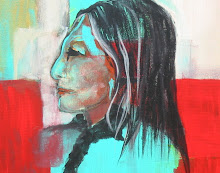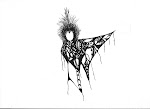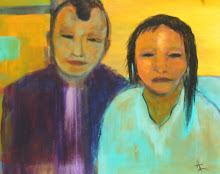Good day. Spoke with Steven M. Sachs Ph.D. today. He publishes a non-juried journal entitled "Indigenous Policy", http://www.indigenouspolicy.org/ . Interesting reading. Because of our conversation, I am thinking I might submit a small article about Oklahoma Indian families and their migration to Phoenix, Arizona in the 1940's.
Why you ask, well my own little Chickasaw family left the Sulpher area around that time and my grandmother, a lucky (?) Indian woman, found employment as a laundress at the Indian TB Sanitarium, in Phoenix. Because she had little education, granma was given the job of boiling soiled linens that bore sputum and blood stains from the lungs of TB infected patients in large pots on 110 degree days. It wasn't a perfect job but it was the only one she could find that provided both room and board for grandma and mom. They lived on the campus of the hospital and because there was no room for families my grandfather, and mom's older siblings, were forced to live elsewhere. Granma's paycheck supported them all. The impact on our family is representative of what was happening to other Indian families who left Oklahoma as a means of surviving the times. The family groups were fractured and irretrivably broken after only a few short years.
The question I have always wondered about is this, did the Indian health mangement policies of the time lead to the break down of our family or was it at an earlier time in Oklahoma with the loss of the land allotment that broke our family? Hmmmmm. Policy and indigenous folks... Genocide, granma tested positive for the scratch TB test for the rest of her life, and assimilation. Are they one and the same?
Thursday, March 27, 2008
Wednesday, March 19, 2008
American Indian Inclusion Manual written by Martin Reinhardt, Ph.D.
Blogging is such a wonderful way of connecting with folks. After the previous post, regarding the American Indian Inclusion Manual, I received an email from the author, Dr. Martin Reinhardt. The following is a snipit of the message he sent to me regarding the manual, "I am glad to see it being used. You can use the info below for attribution if you like. I am Anishinaabe Ojibway, a citizen of the Sault Ste. Marie Tribe of Chippewa Indians".
Dr. Reinhardt's contact information:
Martin Reinhardt, Ph.D.
Research Associate
Interwest Equity Assistance Center
Colorado State University
410 Seventeenth Street, Suite 1419
Denver, Colorado 80202
(303) 623-5531
Cell: (720) 209-5190
Fax: (303) 623-9023
martinr@cahs.colostate.edu
http://www.colostate.edu/programs/EAC/
Dr. Reinhardt's contact information:
Martin Reinhardt, Ph.D.
Research Associate
Interwest Equity Assistance Center
Colorado State University
410 Seventeenth Street, Suite 1419
Denver, Colorado 80202
(303) 623-5531
Cell: (720) 209-5190
Fax: (303) 623-9023
martinr@cahs.colostate.edu
http://www.colostate.edu/programs/EAC/
American Indian Inclusion Manual
The American Indian Inclusion Manual was created as a guide for both Indian and non-Indian educators seeking to include the Native American perspective in subjects across the curriculum.(http://edoptions.com/indianed/American_Indian_Inclusion_Manual.pdf)
*The manual is a great way to learn how to include American Indian concepts and issues across all subjects
* It will also help to expand cultural understanding and how to apply these concepts beyond the standard Native studies curriculum
* Great educational strategies for both Native and non-Native educators
* This information can be downloaded at: http://www.edoptions.com/indianed/
*The manual is a great way to learn how to include American Indian concepts and issues across all subjects
* It will also help to expand cultural understanding and how to apply these concepts beyond the standard Native studies curriculum
* Great educational strategies for both Native and non-Native educators
* This information can be downloaded at: http://www.edoptions.com/indianed/
Tuesday, March 4, 2008
Great Quote By American Indian Artist
There are three kinds of people: first, the "dreamers and doers" who get things done; second, the people who "step in and try to take over" after something is finished; and third, the "yapping dogs" who sit on the sidelines...
-Janelle Romero, American Indian Actor, Producer
-Janelle Romero, American Indian Actor, Producer
Sunday, March 2, 2008
AZCARMEN INDIANPRENUER FOR MARCH INDIGENOUS INTERNET CHAMBER OF COMMERCE
Az Carmen has been chosen as the Indianprenuer for March 2008, by the Indigenous Internet Chamber of Commerce. Her interview and more of her paintings can be seen at: http://www.iicoc.com/entrepreneur_march_2008
The Indigenous Internet Chamber of Commerce is a great site and the owner, Larry Knudtsen, is a man who is serious about encouraging American Indian artists to market their artwork. I recently found the IIOCC site through NATIVE BIZ; an American Indian internet publication. Be sure and connect with Larry after going to his site, http://www.iiocc.com/
The Indigenous Internet Chamber of Commerce is a great site and the owner, Larry Knudtsen, is a man who is serious about encouraging American Indian artists to market their artwork. I recently found the IIOCC site through NATIVE BIZ; an American Indian internet publication. Be sure and connect with Larry after going to his site, http://www.iiocc.com/
Subscribe to:
Posts (Atom)






